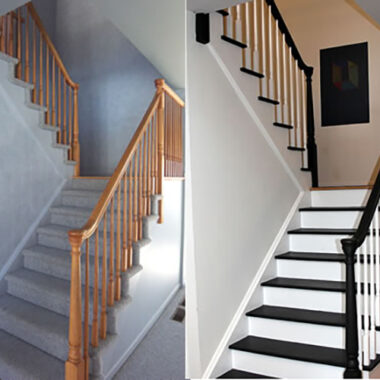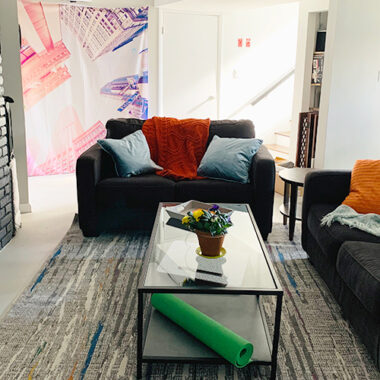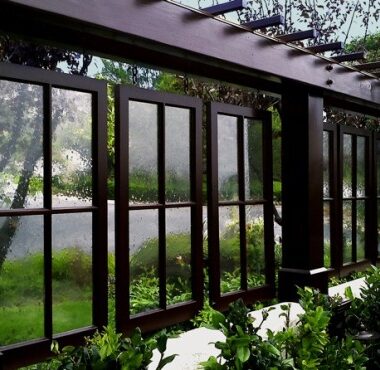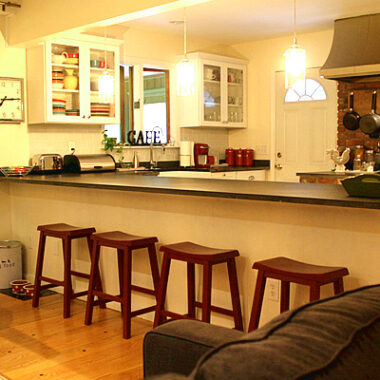Welcome back Guest Poster Samantha Peters! She is a blogger who enjoys writing about ways to turn rooms within a house into more usable and enjoyable spaces. She currently lives in San Diego, California with her dog. I love her thoughtful considerations as to what makes up the tone of a room.
When you walk into your living room, what do you think? What feeling does this room create in you, a positive sense of comfort or an adverse feeling of alienation or claustrophobia? In the home design world, there is much talk about the “tone” or “energy” of a room, meaning the general feel one gets upon entering the space.
Rather than an immersion into the supernatural, this term refers more to the mise-en-scene the totality of different elements that come into play. These usually include light, flooring, form, color and furniture/furnishings. All of these elements combined dictate the “energy” of your room and this energy can define the experience of your living space.
Here are five ways to define the tone of your room:
1. Light

Whether a room is flooded with a preponderance of external natural light from windows or is bathed in artificial lamplight, how you choose to light a room makes a huge difference on the overall feel. Do you want a lambent, shadowy, mysterious glow or a welcoming and even light? It also matters how the lighting pairs with the color scheme of a room.
2. Flooring

The flooring you use will meld with the light and other elements, but is distinctively important on its own. Your initial decision is between hardwoods and carpets. The latter is cheaper and can usually be implemented quicker. Carpet stores also generally have more options for pattern and texture customization so that you can match the color and style of your furniture without breaking the bank. Area rugs are also a good option as they can help to sectionalize a room, add secondary color, and protect your hardwoods.
3. Form

(via)
Form refers to the general shape of a room and architectural interests: wall dimensions, ceiling height, geometric structure, etc. For example, a low-ceiling, spherical room is going to feel different than a hexagonal room. There are ways to manipulate the form of a room with mirrors and furniture placement. Mirrors are often used to enhance the dimensions of a room, making it seem more spacious. Furniture placement also can subjetively increase the size of a room and open up more pathways, making it easier to move around.
4. Color
(via)
Color, as we know, contributes a lot to the tone of a room in a very subjective way. Interestingly, color can be used architecturally. Try using a slightly lighter or darker shade on the doorway or molding over your main wall. Or use two different colors in the same room. OR, try a copper or bronze tone to add dimensions to arhitecturally versatile room.
5. Furniture and furnishings
(via Coastal Living Magazine)
These two can generally be paired together when considering the “tone” of the room. Furniture size, placement and aesthetic touch is often heavily dependent on furnishings like lamps, plants, rugs, mirrors and decorations.
Next time you’re designing a room, consider the interplay of these five elements. You don’t necessarily have to get an interior decorator, but if you’re aiming for a particular room tone, or “energy,” you’ll need to carefully combine lighting and flooring with the form and furnishings of a room.
So here’s a challenge, walk through the rooms of your home, and try to define what each room’s tone is. Is there a room you’d like to change? Try some of Sam’s ideas! Also, follow her on Twitter!











10 comments
love your idea with color. does artwork ever play a role?
I just moved into a new place and have been looking for some design tips, trying to put together a comfortable and relaxing living space. The tone of a room really can change your feeling and attitude. There are some really great tips here!
I have been designing my living spaces for many years now and I think this is a great list for beginning designers. It sometimes can be quite overwhelming to try and set a mood for a room or space, but if you take it step by step and address the different aspects of a room you can tackle anything!
Whose pictures are the examples above? They are just very elegant and exemplifies the characteristics of a room.
-Emma
I really like what you have suggested here. Lighting can really set the tone of a room, and I believe it is one of the most important aspects of any living space. I personally like light spaces with lots of outside light.
Hi Lilly,
Thanks for the nice comments. Susan was the one who added these pictures to my post and sure does have an amazing eye for it.
I too a somewhat a perfectionist when it comes to decorating my rooms. Sometimes it can difficult to put your finger on the right “tone” but when you get it right it can make all the difference.
I really do the ideas in this post can help solve your problems. I am sure you’ll get it right!
I agree that golden lighting really makes a room feel comforting and inviting. It can be a nice touch especially in the bedroom.
Nice post and lovely pictures.
I’m someone who is never satisfied with the decoration of her room. I always feel that something is missing. I think I was missing the “tone” of my rooms. I hope your post manages to solve my problems.
Thanks for sharing.
-Lilly
Interesting post. I recently was looking through my “Looks I Love” board on Pinterest. I noticed that almost every one had golden light in it – whether via candlelight, moon light, or plain old bulb with a tan shade. So, that apparently moves me.
~ Dana